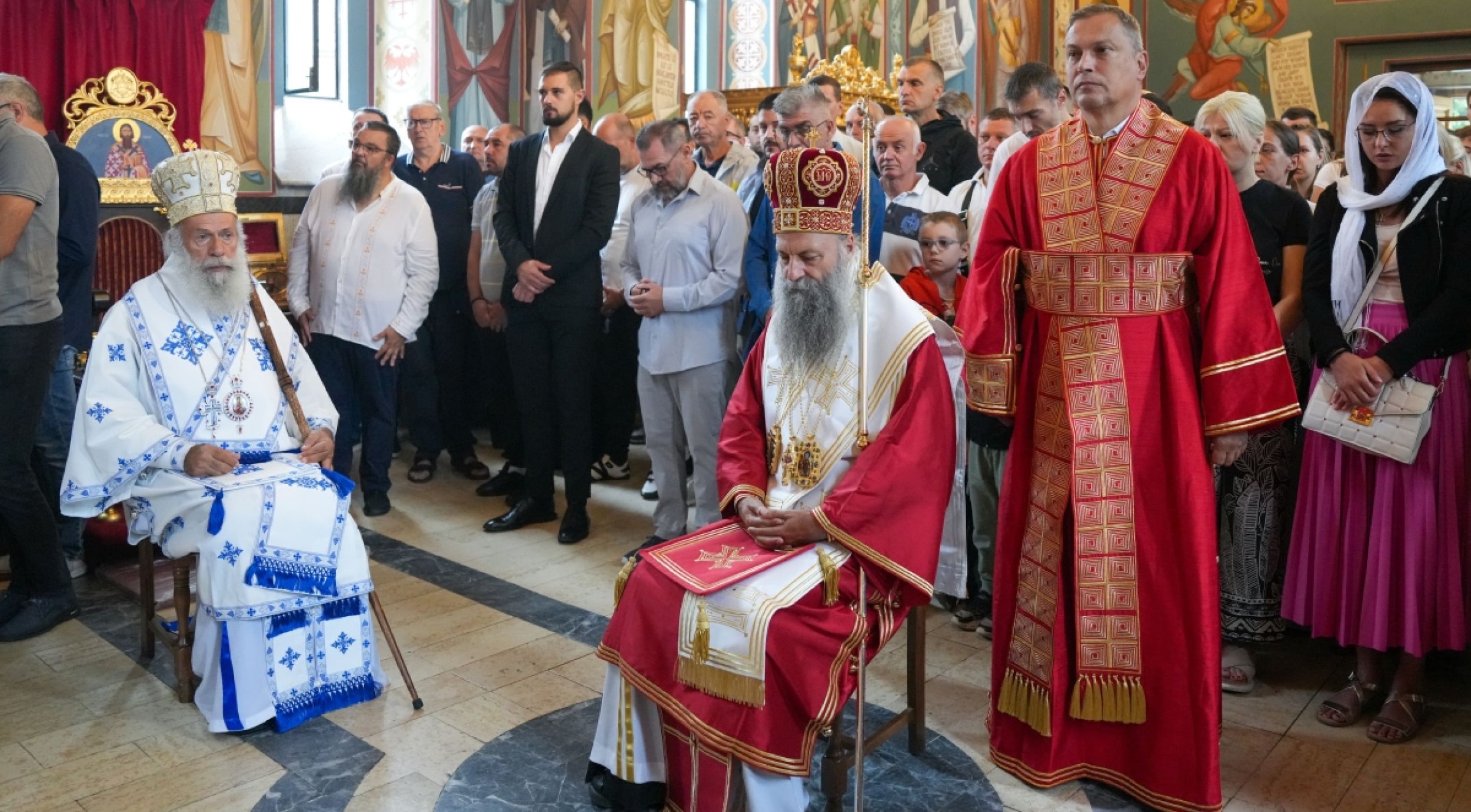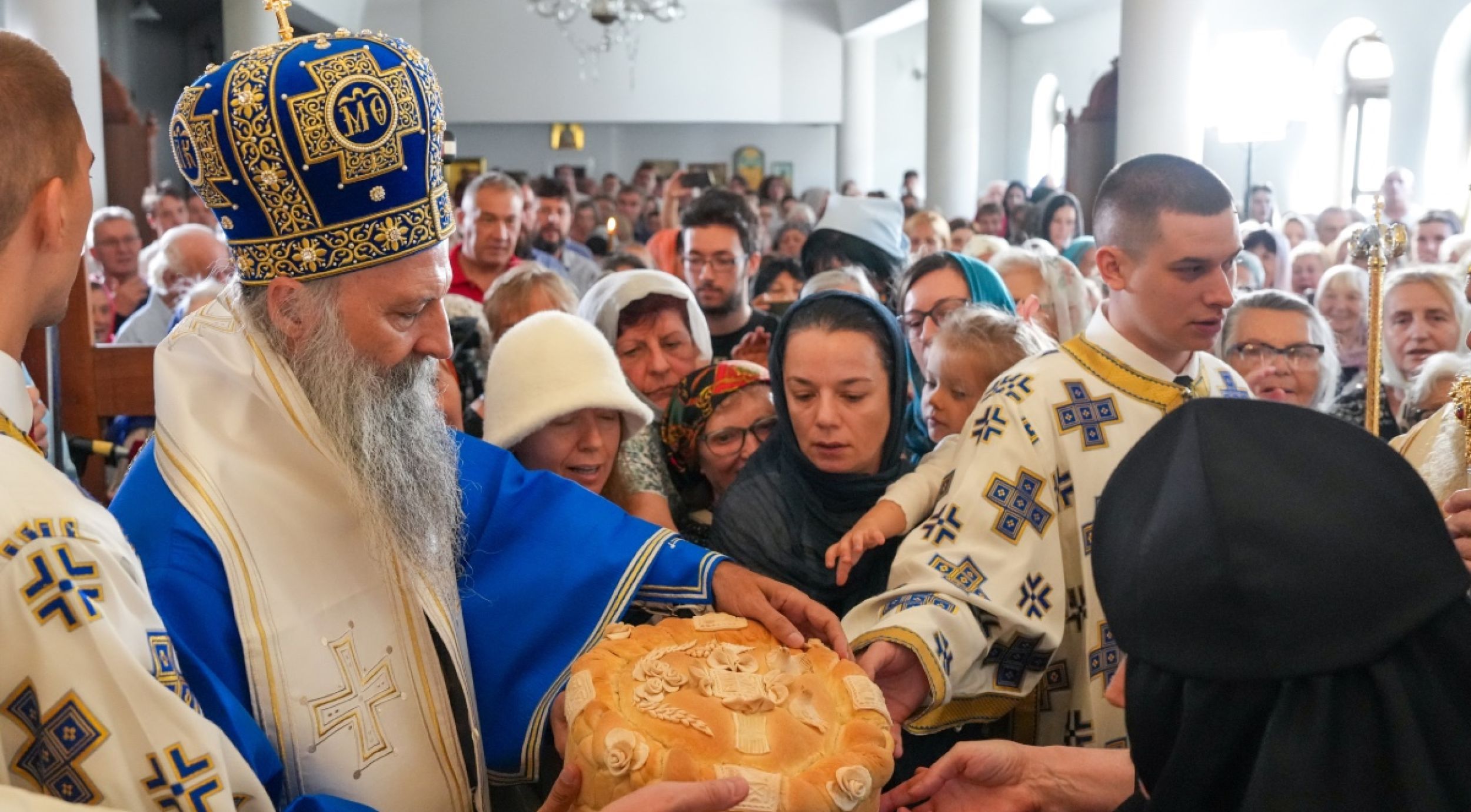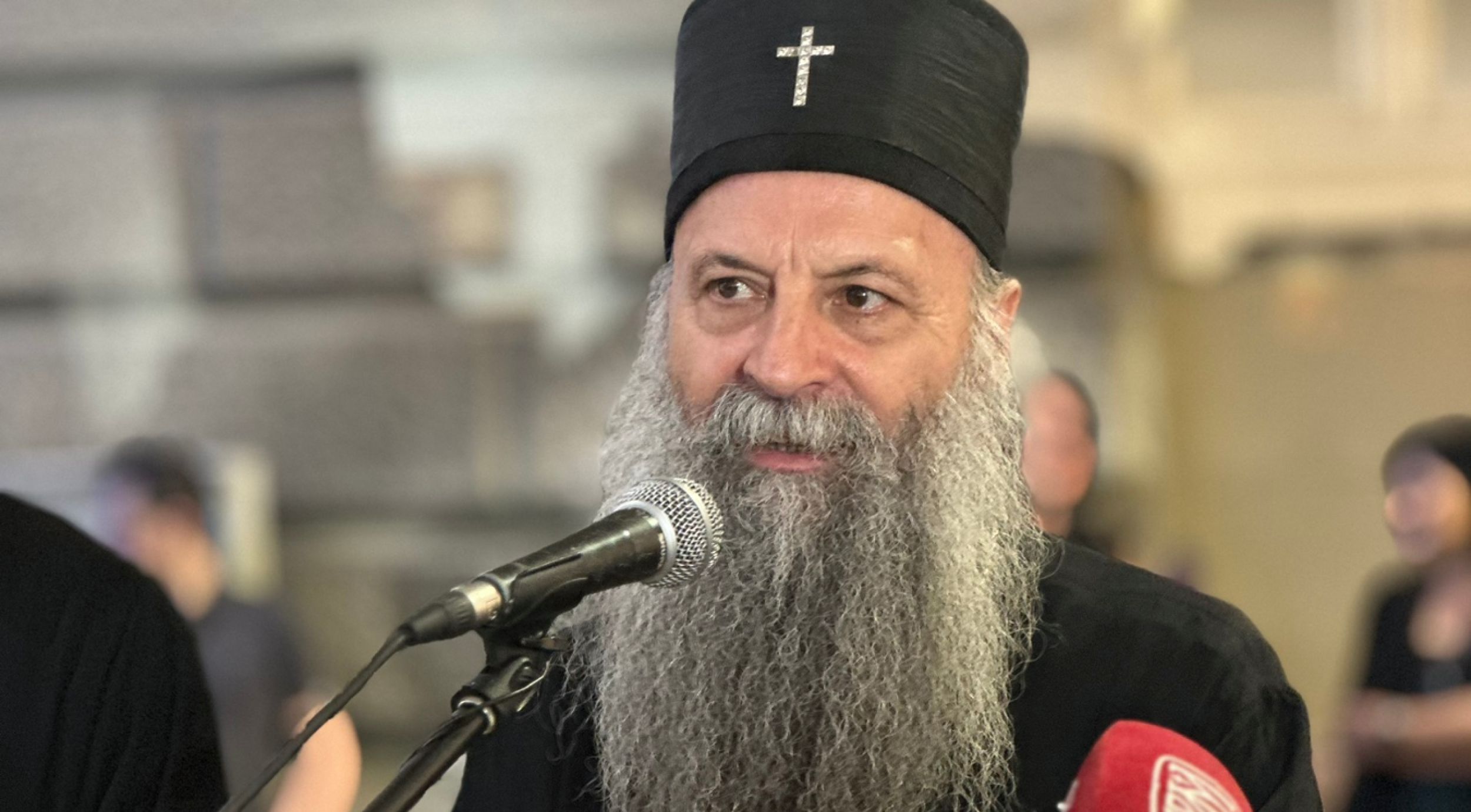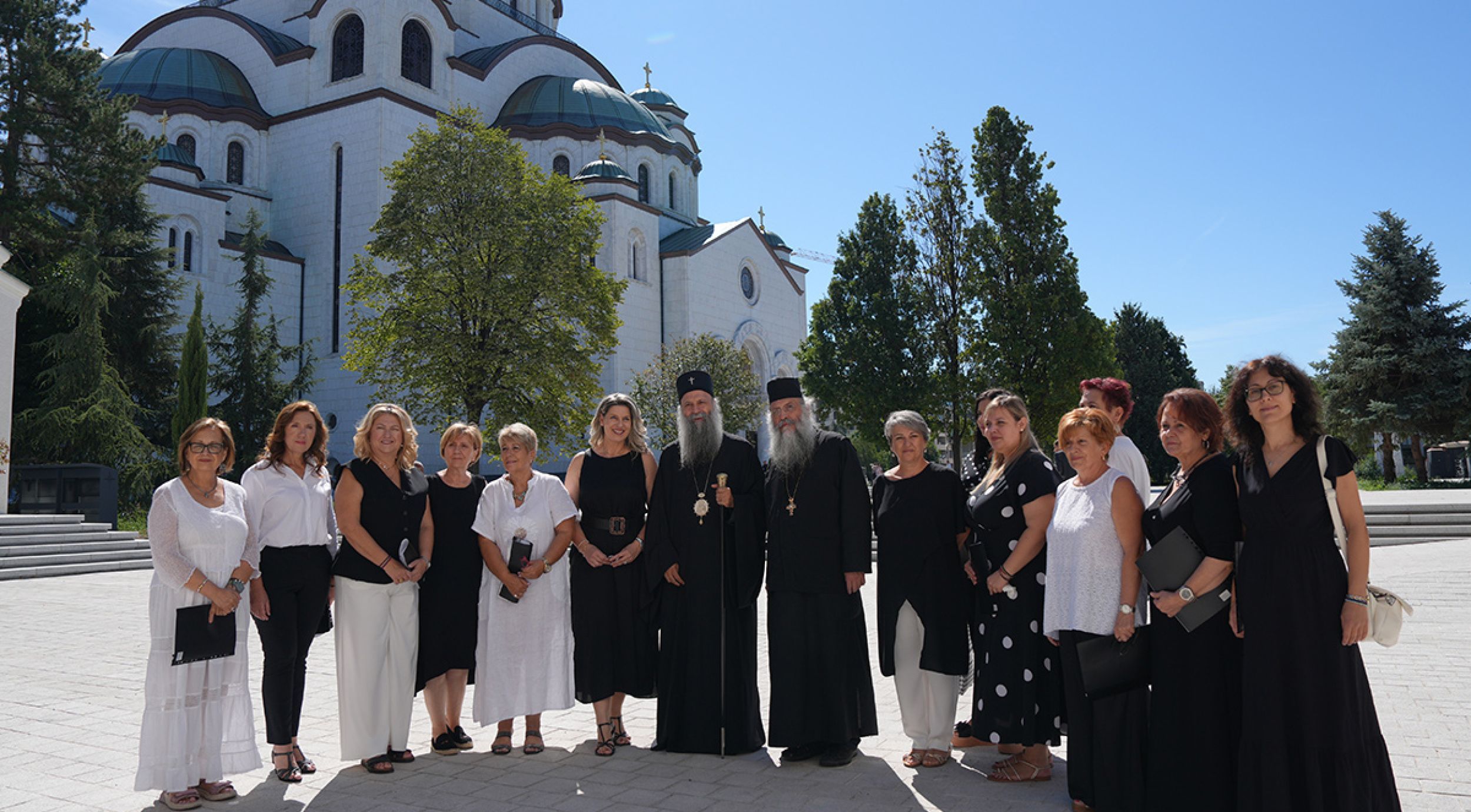Patriarch Porfirije: We show love for God in our encounter with our neighbor
His Holiness Serbian Patriarch kyr Porfirije celebrated the Holy Hierarchical Liturgy on 24 August 2025, in the Church of Saint Stefan of DeƒНani in ≈љeleznik.
After the reading of the Holy Gospel, His Holiness first reminded the faithful of the importance of participation in the Divine Liturgy, emphasizing: Wherever the Divine Liturgy is, there is the Lord Jesus Christ Himself; it is the mystery of the Kingdom of Heaven. Preaching on the Gospel parable of the two debtors (Mt. 18:23вАУ35), His Holiness pointed out that the master in the parable represents God Himself, and the first servant represents each one of us:
вАФ We have all received immeasurably many gifts from the Lord, given to us so that through them we may become participants and dwellers of the Kingdom of God. How? By believing in God, by loving Him with our whole being, by striving to live in accordance with the paths and guidelines He has given us to serve as aids in our life. Those paths and guidelines are nothing other than our natural state. But how do we love God, how do we listen to His guidance and fulfill His commandments, and how does that become our life? How is it seen? It is most easily and most simply seen in our relationships with one another, in our attitude toward our neighbor. When we encounter our neighbor, the other, our brother or sister, we have the opportunity to bear witness, to love them as ourselves, to fulfill the commandment of God. We have the opportunity to understand that our neighbor is not our rival, that our neighbor, God forbid, is not given to us to be hated, to be our enemy, no matter how different he may be and no matter who he may be, for every human being is the image of God, upon each is imprinted the seal of Christ. And every person is therefore, in that sense, a gift to us, and every person is, in that sense, a brother or a sister. The measure of how much we love God will be shown precisely in these mutual relationsвАФhow much a husband loves his wife, how much a wife loves her husband, how much they love their children, how much children love their parents, how much we love our neighbors or the people with whom we work.
вАФ Only in the encounter of forgiveness, in the embrace with one another, regardless of the various obstacles that exist among us, will we testify that we are the people of God. And not only that, but we will also live the mystery of the Kingdom of Heaven here and now. And when the Lord calls us to meet Him, we will not experience His Kingdom as foreign, nor will we feel that we are superfluous there, but on the contrary, we will know that we are welcome, and that this is the meaning, the fullness, and the goal of our existence in general вАФ preached His Holiness Patriarch Porfirije, whose entire sermon in Serbian may be read HERE.
Concelebrating with the Primate of the Serbian Orthodox Church were: His Grace Vicar Bishop of Hvosno kyr Aleksej; Archimandrite Prokopije (of the Antiochian Orthodox Church); Archpriests Goran Mi≈°anoviƒЗ, Sini≈°a TriviƒЗ, and Aleksandar GagiƒЗ; Priest Milo≈° Vilenica вАУ the Dean of the Church of Saint Stefan; Protodeacons Dragan RadiƒЗ and Radomir VruƒЗiniƒЗ; and Deacons Vasilije PeriƒЗ and Lazar SimiƒЗ.
+++
The Church of Saint Stefan of DeƒНani in ≈љeleznik was built in 1906 on the site of the old village cemetery in ≈љeleznik, with its foundations consecrated in 1905. The principal benefactor of the church was Katarina JovanoviƒЗ from Belgrade. Alongside her, significant contributions were also made by the municipality of ≈љeleznik and a local resident, Radovan RadojeviƒЗ.
The church was consecrated on April 16, 1906, by Metropolitan Dimitrije of Belgrade, with King Peter I KaraƒСorƒСeviƒЗ in attendance. Through the efforts of the benefactress Katarina JovanoviƒЗ, the church was separated from the Ostru≈Њnica parish in 1909 and a distinct ≈љeleznik parish was formed.
During the fighting in 1914, the church was plundered and damaged and also served as a hospital for the wounded. In memory of the 210 victims from ≈љeleznik during the Great War, a monument was erected in the churchyard. In the crypt of the church is also located the family tomb of the benefactress, Katarina JovanoviƒЗ.
After the reading of the Holy Gospel, His Holiness first reminded the faithful of the importance of participation in the Divine Liturgy, emphasizing: Wherever the Divine Liturgy is, there is the Lord Jesus Christ Himself; it is the mystery of the Kingdom of Heaven. Preaching on the Gospel parable of the two debtors (Mt. 18:23вАУ35), His Holiness pointed out that the master in the parable represents God Himself, and the first servant represents each one of us:
вАФ We have all received immeasurably many gifts from the Lord, given to us so that through them we may become participants and dwellers of the Kingdom of God. How? By believing in God, by loving Him with our whole being, by striving to live in accordance with the paths and guidelines He has given us to serve as aids in our life. Those paths and guidelines are nothing other than our natural state. But how do we love God, how do we listen to His guidance and fulfill His commandments, and how does that become our life? How is it seen? It is most easily and most simply seen in our relationships with one another, in our attitude toward our neighbor. When we encounter our neighbor, the other, our brother or sister, we have the opportunity to bear witness, to love them as ourselves, to fulfill the commandment of God. We have the opportunity to understand that our neighbor is not our rival, that our neighbor, God forbid, is not given to us to be hated, to be our enemy, no matter how different he may be and no matter who he may be, for every human being is the image of God, upon each is imprinted the seal of Christ. And every person is therefore, in that sense, a gift to us, and every person is, in that sense, a brother or a sister. The measure of how much we love God will be shown precisely in these mutual relationsвАФhow much a husband loves his wife, how much a wife loves her husband, how much they love their children, how much children love their parents, how much we love our neighbors or the people with whom we work.
вАФ Only in the encounter of forgiveness, in the embrace with one another, regardless of the various obstacles that exist among us, will we testify that we are the people of God. And not only that, but we will also live the mystery of the Kingdom of Heaven here and now. And when the Lord calls us to meet Him, we will not experience His Kingdom as foreign, nor will we feel that we are superfluous there, but on the contrary, we will know that we are welcome, and that this is the meaning, the fullness, and the goal of our existence in general вАФ preached His Holiness Patriarch Porfirije, whose entire sermon in Serbian may be read HERE.
Concelebrating with the Primate of the Serbian Orthodox Church were: His Grace Vicar Bishop of Hvosno kyr Aleksej; Archimandrite Prokopije (of the Antiochian Orthodox Church); Archpriests Goran Mi≈°anoviƒЗ, Sini≈°a TriviƒЗ, and Aleksandar GagiƒЗ; Priest Milo≈° Vilenica вАУ the Dean of the Church of Saint Stefan; Protodeacons Dragan RadiƒЗ and Radomir VruƒЗiniƒЗ; and Deacons Vasilije PeriƒЗ and Lazar SimiƒЗ.
+++
The Church of Saint Stefan of DeƒНani in ≈љeleznik was built in 1906 on the site of the old village cemetery in ≈љeleznik, with its foundations consecrated in 1905. The principal benefactor of the church was Katarina JovanoviƒЗ from Belgrade. Alongside her, significant contributions were also made by the municipality of ≈љeleznik and a local resident, Radovan RadojeviƒЗ.
The church was consecrated on April 16, 1906, by Metropolitan Dimitrije of Belgrade, with King Peter I KaraƒСorƒСeviƒЗ in attendance. Through the efforts of the benefactress Katarina JovanoviƒЗ, the church was separated from the Ostru≈Њnica parish in 1909 and a distinct ≈љeleznik parish was formed.
During the fighting in 1914, the church was plundered and damaged and also served as a hospital for the wounded. In memory of the 210 victims from ≈љeleznik during the Great War, a monument was erected in the churchyard. In the crypt of the church is also located the family tomb of the benefactress, Katarina JovanoviƒЗ.





